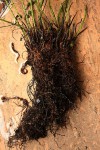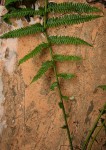Pseudocyclosorus pulcher (Willd.) Holttum
Synonyms |
Thelypteris longicuspis (Baker) Schelpe |
|---|---|
Common name |
|
Description |
Rhizome erect, sometimes forming a caudex up to c. 30 cm high, often covered with dead frond bases; rhizome scales up to 5 mm long, ovate, almost entire, apex pointed, light brown,. Fronds monomorphic, tufted, 0.8-2 (2.5) m long, arching, not proliferous, coriaceous. Stipe up to 70 cm long from the base to the first large pinnae, matt brown, thinly set with minute white hairs. Lamina up to 1.6 × 0.66 m, deeply 2-pinnatifid, abruptly decrescent towards the base into a long series of strongly reduced pinnae, lanceolate-oblong in outline, apex pointed; pinnae linear-oblong, largest pinnae 20-33 x 2-3.5 cm, ultimate lobes oblong, slightly falcate, margin entire, up to 1.8 x 0.4 cm, upper surface densely hairy along the costae with white hairs, sparsely on the veins, under surface sparsely glandular with scattered, pale hairs, veins up to 18 pairs, not meeting below or in the sinus; rhachis pale brown, hairless. Sori up to 25 per lobe, halfway between costule and margin, almost reaching the top of each lobe, round; indusia subcircular to reniform, lacerate, glandular. |
Notes | Pseudocyclosorus pulcher look for: erect rhizome, basal pinnae abruptly reduced into a series of small vestigial pinnae, veins not meeting in or at the sinus. |
Derivation | pulcher: beautiful, handsome |
Habitat | Riverine forest, shaded moist forest floorsseasonally inundated bushland, lake and stream banks, swamp edges. |
Distribution worldwide | Sudan, tropical Africa, S. Africa, Madagascar and the Mascarenes. |
Distribution in Africa |
Angola, Burundi, Cameroon, Congo, Dem. Republic of Congo, Equatorial Guinea (incl. Bioko), Ethiopia, Kenya, Malawi, Mozambique, Nigeria, Rwanda, South Africa, Tanzania , Uganda, Zambia, Zimbabwe. |
Growth form |
Terrestrial. |
Literature |
|


